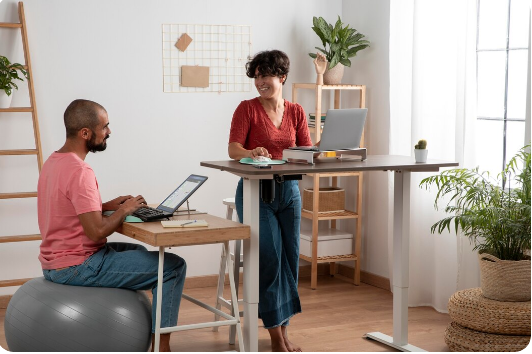The pandemic flipped the office world upside down, and now that people are coming back, they’re not interested in returning to the same old setup. Remote work gave everyone a taste of flexibility and comfort, and that’s completely changed what they expect from office spaces.
Here’s the thing: people got used to working in spaces they controlled. They set up home offices that actually worked for them—comfortable chairs, good lighting, quiet environments. Now companies are realizing their offices need to compete with that. Simply having desks and chairs isn’t enough anymore, which is why many are rethinking their approach, including exploring budget-friendly used office furniture options that still deliver on quality and comfort.
The biggest shift? Offices aren’t just about having a place to sit anymore. They need to offer something people can’t get at home. That usually means better collaboration spaces, technology, and social interaction. If your office is just rows of desks, people would rather stay home where they’ve got their own setup dialed in.
Flexibility has become non-negotiable. Employees want options for how they work throughout the day. Sometimes they need quiet focus time, other times they’re collaborating with teammates, and sometimes they just need a change of scenery. The old cubicle farm model where everyone sits in the same spot all day? That doesn’t cut it anymore. Modern approaches to flexible workspace design emphasize variety and choice.
Think about what actually makes people want to come into an office. It’s usually not the desk—it’s the stuff that’s harder to replicate at home. Good meeting rooms with proper video conferencing setup for hybrid calls. Comfortable lounges where people can have informal conversations. Kitchen areas that feel inviting. Phone booths for private calls. These are the spaces that justify the commute.
Technology expectations have skyrocketed too. Everyone’s gotten used to the simplicity of jumping on a video call from home with one click. Office meeting rooms need to work just as smoothly, if not better. Clunky conference systems that take 10 minutes to figure out? Nobody has patience for that anymore.
The nine-to-five, everyone-in-the-office model is fading fast. Hybrid schedules are becoming standard, which means offices need to accommodate varying headcounts throughout the week. Hot desking and shared workstations are replacing assigned seating. Storage solutions are different when people aren’t keeping their stuff at a desk permanently.
Comfort has also moved up the priority list. When you’re choosing to come in rather than working from your couch, the office experience better be worth it. That means investing in quality seating, proper lighting, temperature control that actually works, and spaces that feel thoughtfully designed rather than thrown together.
There’s a social element that can’t be ignored either. Remote work made a lot of people feel isolated. Offices that foster connection—through layout, communal spaces, and casual gathering spots—address one of remote work’s biggest downsides. According to research from the Society for Human Resource Management, well-designed social spaces significantly impact employee satisfaction and retention.
Here’s what’s not working anymore: treating the office like it’s 2019. Employees have experienced a different way of working, and many prefer it. The offices that succeed are the ones that acknowledge this and adapt. They’re creating spaces that offer genuine advantages over working from home.
Companies are also realizing they might not need as much space as before. If not everyone’s in every day, downsizing square footage while upgrading quality makes financial sense. Smaller, better-designed spaces often work better than large, mediocre ones.
The bottom line? Remote work raised the bar for what an office should be. Employees now expect spaces that are flexible, comfortable, tech-enabled, and designed with intention. They want offices that enhance their work rather than just house it.
If your office still looks and functions like it did before 2020, you’re probably losing the battle for employee engagement. The question isn’t whether to adapt—it’s how quickly you can make it happen.
